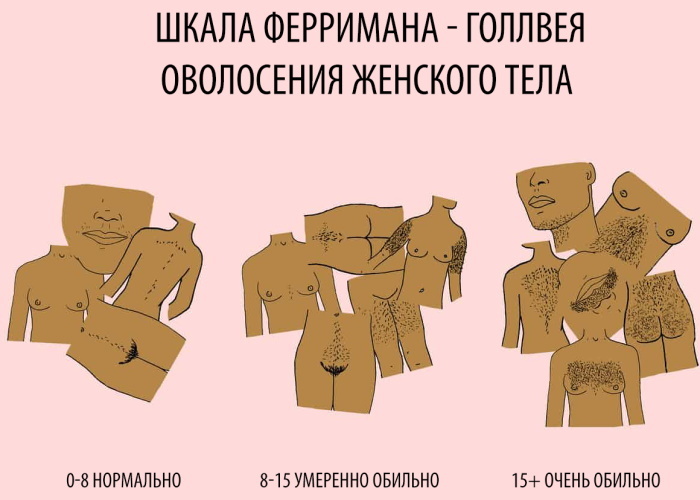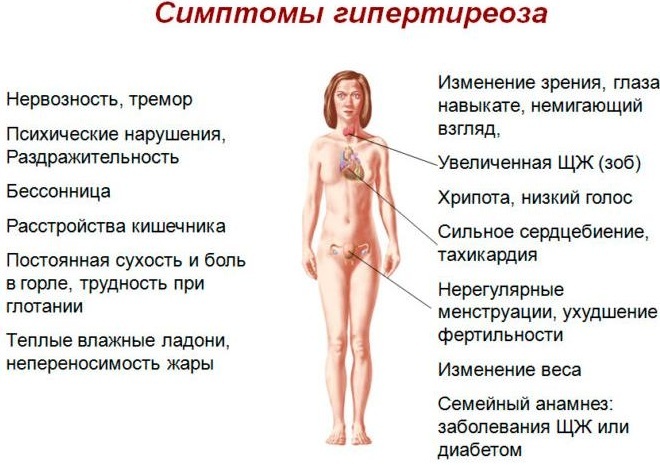Content
- Anatomy of the nipple in women and their function
- Appearance
- Nipple and areola shade
- What is the areola, what determines the size
- Types and shapes of nipples
- Convex
- Flat
- Plump
- Retracted
- Versatile (one-sided)
- Lumpy
- With hairs
- Third nipple
- Direction of the nipples
- Methods for correcting the shape of the nipples
- Sunken Correction
- Bulge correction
- With a fuzzy outline
- Video about female nipples
Female nipple - it is an integral part of the mammary gland, which looks like a rounded protruding protrusion. The innervation of the tissues of this part of the chest is provided by the peripheral branches of the 4th intercostal nerve. According to the form of development, female nipples are absolutely flat, convex, rounded, puffy. In pregnant women, the areola of the nipple has a darker shade from coffee to deep brown.
Anatomy of the nipple in women and their function
In women, the nipple is located just below the median section of the mammary gland on the line of the 5th rib, or in the region of the 4th intercostal space. In women who have previously given birth, the nipple has a cylindrical shape, and in those who have not given birth, it looks like a cone in appearance.
The following anatomical features of female nipples are distinguished:
- areola with a diameter of 3 to 5 cm;
- the milk canal, through which mother's milk flows from the nipple during the lactation period of a newborn baby;
- adipose tissue located inside the breast under the nipple;
- skin covering.
The areola contains a small number of mammary glands, which have rudimentary features. These anatomical elements of the breast form elevations on the surface of the nipple. These rudimentary tubercles are called Montgomery's glands. The skin of the female nipple is covered with multiple wrinkles, and in its upper part there are milky pores.
The table below details the physiological functions of the female nipple:
| Functions of a woman's nipple | Characteristics of physiological processes |
| Sexual arousal | During sexual intercourse, as well as during ovulation, the erectility of the nipple increases due to a sharp contraction of its muscle fibers. The occurrence of this physiological reaction is not associated with an increase in local blood circulation. At the time of sexual arousal, female nipples acquire an elongated conical shape. |
| Lactation | Delivery of breast milk to a baby is the main function of a female nipple. Excretion of breast milk occurs throughout the entire lactation period of the newborn. |
| Restoration of internal genital organs | The sensitive muscles of the nipples are directly involved in the recovery of the female reproductive system after the birth of a child. When a newborn breastfeeds, the hormone oxytocin is released into the mother's bloodstream. It is a biologically active substance that contributes to the rapid contraction of the uterus in the first hours after childbirth. Regular stimulation of the mother's nipples by the child provides the effect of constricting the uterine arteries, which minimizes the risk of developing postpartum hemorrhage. |
After the end of the lactation period, the woman's breasts gradually decrease in size. The areola acquires a lighter color shade, the nipples become less voluminous, and their length decreases.
Appearance
Types of nipples in women are classified according to color, shape, and distinctive features of the areola.
Nipple and areola shade
The pigmentation of the nipple and its areola changes depending on the woman's hormonal background, skin tone and hair color. During pregnancy, the areola turns a deep brown color as the fetus develops. After the birth of the baby, the physiological process of gradual lightening of the areola of the nipple starts.
In girls with dark skin and black hair, the areola is initially distinguished by a darker shade. In women with white, light brown or red hair, light skin, the areola is naturally light red in color. The biochemical substances of the female body are responsible for the shade of the areola - eumelanin (rich brown) and pheomelanin (causing the areola to stain red).
What is the areola, what determines the size
The areola is the pigmented area of the breast that sits around the nipple.
The size of this part of the chest depends on the influence of the following factors:
- the state of pregnancy and the period of development of the fetus;
- phase of the menstrual cycle;
- hormonal changes caused by diseases of the endocrine and reproductive systems;
- the period of natural aging of the body;
- lactation of a newborn baby by breastfeeding;
- long-term therapy with drugs that contain natural or synthetic hormones;
- hereditary predisposition (the size of the areola is transmitted along with genetic information from mother to daughter).
The average diameter of the areola in women is within 3 cm. Some girls may have a areola larger than 10 cm. The presence of these parameters of the mammary gland is not a pathology. The size of the areola increases dramatically with the start of breastfeeding. Most women have a regular, round areola. In rare cases, an areola is found in the form of an ellipse.
Types and shapes of nipples
Types of nipples in women differ in the shape and color pigmentation of epithelial tissues. This part of the mammary gland can be more convex, plump, bumpy, completely flat, pulled into the breast.
Convex
Nipples of this type are also called "protruding", and their distinctive feature is that they protrude several millimeters above the general level of the areola. At the moment of sexual arousal, under the influence of too hot or cold air currents, the bulging areola become even more noticeable.
Flat
Fully flat nipples occur in 60% of women. This part of the breast does not protrude above the general level of the areola, does not react in any way to sexual arousal. 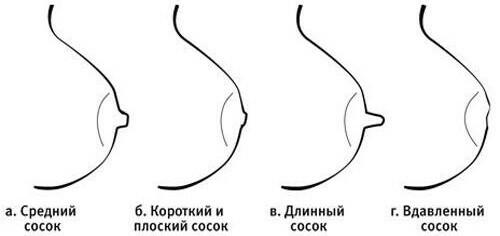 The presence of such a physiological reaction of the body, the inaction of the muscle fibers of the chest in response to external and internal stimuli is not considered a pathology.
The presence of such a physiological reaction of the body, the inaction of the muscle fibers of the chest in response to external and internal stimuli is not considered a pathology.
Plump
Tapered or swollen nipples also protrude above the general level of the skin. A distinctive feature of this form of nipple is that they sharply increase in volume before the onset of menstruation. At the end of menstruation, there is a gradual decrease in the nipples with the restoration of their previous shape. For 2-3 days and during menstruation, touching the areola of the nipple can cause soreness.
Retracted
Inverted nipples can simultaneously be a sign of pathology, or an individual feature of the structure of the female breast. If a girl has this form of nipple from birth, then this is considered the norm.
The following distinctive features of the inverted nipple are distinguished:
- directly the nipple itself and its areola are located below the level of the skin;
- at the time of sexual arousal, the nipple increases in volume, towering above the mammary gland;
- during ovulation, the nipples cease to be retracted, acquiring more noticeable sizes.
The sudden appearance of inverted nipples at a certain stage in life, or a change in their appearance in adolescence age after puberty is a symptom of endocrine disease or imbalance in female genital hormones. In such a situation, it is necessary to be examined by a mammologist and endocrinologist.
Versatile (one-sided)
Versatile nipples are also considered a sign of the norm, but only if this form of the mammary gland is in the girl from birth.
The appearance of unilateral nipples in adulthood or immediately after puberty may indicate the development of the following pathologies:
- mastopathy;
- fibroadenoma:
- mammary cancer;
- lipoma;
- intraductal papilloma;
- mastitis.
The emergence of a versatile form of nipples, which is accompanied by pain in the chest area, bleeding or ichor from the milk duct, requires immediate medical attention to a mammologist or gynecologist.
Lumpy
Types of nipples in women differ in shape, color, areola diameter. Lumpy nipples are found in girls with strongly pronounced Montgomery glands. Outwardly, this part of the breast is distinguished by a large number of small pimpled eminences, which are located directly on the nipple itself, as well as on the surface of the entire areola. Too dense arrangement of Montgomery's glands is not a sign of pathological development of the breast, and also does not indicate the possible presence of a disease.
With hairs
Hairy nipples are also called fluffy nipples. Depending on the hormonal background of the female body, there can be from 1-3 to several dozen hairs within the areola.

The emergence of this physiological feature is due to the fact that the girl's blood contains a high concentration of male sex hormones. Hair follicles are found in the tissues of the nipple areola. The rapid growth of hair on the mammary gland is activated as the concentration of male sex hormones increases.
The appearance of such symptoms is caused by the following causal factors:
- polycystic ovary;
- long-term use of oral contraceptives;
- therapy with drugs that contain synthetic hormones;
- taking steroids and hormone-based sports nutrition products.
Hair growing within the areola as well as on the surface of the nipple is a cosmetic problem. Regular removal of these hairs allows the breasts to return to their previous appearance. The appearance of such a symptom requires a comprehensive examination by an endocrinologist. Especially if the growth of hair within the areola is accompanied by sudden mood swings, pulling pain in the lower abdomen, tearfulness.
Third nipple
The appearance of the third nipple is an anomaly in the development of the mammary gland, which has a congenital origin. A similar defect can be transmitted through the maternal line along with genetic information. In most cases, the third nipple is located near the areola or under the breast. Outwardly, this formation resembles a mole with a diameter of 2-3 mm. The third nipple does not increase in size, does not cause pain or severe discomfort, and does not itch.
Direction of the nipples
Types of nipples in women are classified according to the direction of their location, namely:
- upright;
- lowered down;
- looking in different directions;
- directed inward;
- raised up.
Each direction of the nipples is characteristic of a certain breast shape. This information is detailed in the table below.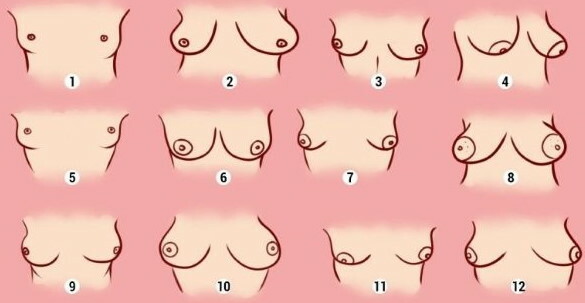
| Breast shape | Direction of the nipples |
| Round | For mammary glands of a round shape, the presence of erect nipples is typical, which rise slightly above the general level of the skin. |
| East-west | An east-west breast is characterized by the presence of nipples that point in different directions. The mammary gland itself outwardly resembles an eggplant. The breasts move away from the center towards the right and left sides. |
| Tilted to the side | Women with breasts that are tilted to the side have erect or inward-looking nipples. These breasts have a wider fit and are larger than average. |
| A tear | The tear-type mammary gland is characterized by the presence of nipples, the tips of which are directed downward. In most cases, this breast has a sagging shape, characterized by low elasticity of the glandular tissue. Similar changes in the structure of the mammary gland are found in women who have dramatically lost weight, for a long period of time, breastfed the baby. Low level of physical activity, excessive thinness also contribute to the rapid sagging of the breasts with a change in the direction of the nipples with their downward movement. |
| Slender | The "slender" type of mammary gland is characterized by the presence of erect or raised nipples. This type of breast is characterized by a slender and neat upper part, as well as a lush bottom volume. |
| Bell | Bell-shaped breasts are characterized by a large volume of glandular tissue and downward nipples. At the same time, the mammary gland itself is quite elastic, and its tissues retain a normal level of elasticity. There are no signs of sagging at all. |
| Asymmetric | In women with “asymmetric” type mammary glands, one breast is slightly larger than the other. In this case, the girl can have nipples in any direction. |
| Cone | Taper breasts are small and erect nipples. The mammary gland of this type has a conical shape, very elastic and elastic. This type of breast is most often found in thin girls who are not prone to obesity. |
| Relaxed | The “relaxed” type of mammary gland is characterized by downward pointing nipples. This type of breast can show signs of laxity, sagging and low elasticity. |
| Athletic | The athletic type of breast is found in women who regularly play sports, have a toned and muscular body. The mammary gland of this type has nipples directed upwards, and is also small in size. |
Under the influence of the natural aging process, due to changes in hormonal levels, the shape of the breasts and the direction of the nipples can change. A sharp increase in one mammary gland is a sign of a pathology that requires consultation with a mammologist.
Methods for correcting the shape of the nipples
There are several ways to correct the irregular shape of the nipples, which has a congenital or acquired etiology.
Sunken Correction
Sunken nipples of the breast can occur due to breast disease, age-related changes associated with loss of tissue elasticity. In this case, a surgical method is used to correct deformational changes in tissues in the areola.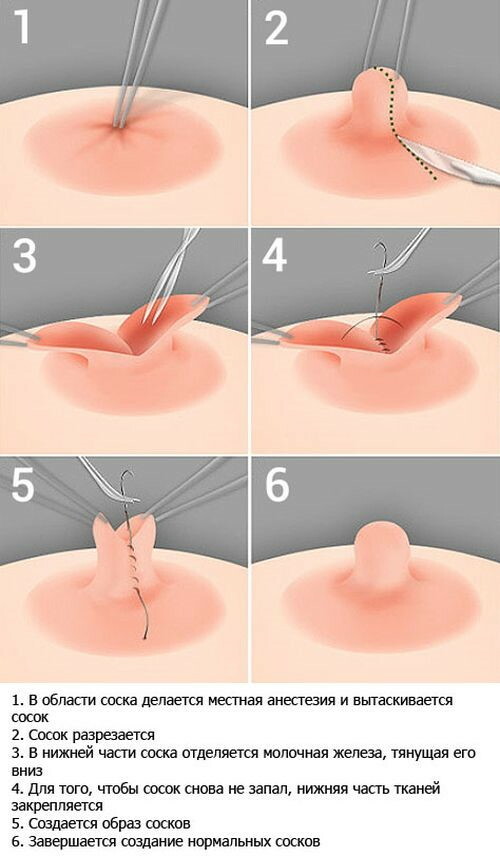
Restoring the normal shape of sunken nipples is carried out according to the following algorithm of actions:
- The woman is admitted to the hospital of the plastic surgery department.
- At the appointed date and time, the patient is transported to the sterile conditions of the operating room.
- The anesthesiologist administers general anesthesia to the girl.
- An antiseptic treatment of the surface of the nipple and areola is carried out.
- The plastic surgeon makes an incision in the epithelial tissue at the bottom of the nipple base.
- Using surgical instruments, the doctor lifts the nipples and areola, and also crosses the ducts that pull them into the breast.
- Sanitation of damaged tissues is performed to prevent bleeding.
- The surgeon sutures the operated area of the breast.
- The patient is transferred to the intensive care unit for 1 day in case of postoperative complications.
- 24 hours after the surgery, the woman is admitted to the general ward, where she undergoes further recovery.
On the 5-6th day after the operation, the surgeon may decide to remove the stitches from the operated nipples of the patient. After removing the suture material, the doctor conducts a control examination of the girl's chest, evaluates the result of the operation performed. To prevent the infectious and inflammatory process, the patient is prescribed antiseptic drugs for external treatment of the operated tissues.
Bulge correction
Too bulging nipples can also be corrected with surgery.
In this case, the following treatment tactics are used:
- The woman, who is in the hospital of the plastic surgery department, is transferred to the sterile conditions of the operating room.
- The anesthesiologist will administer general intravenous or epidural anesthesia to the patient, depending on the medical indication.
- Antiseptic treatment of the skin of the mammary gland, areola and nipple is carried out.
- The surgeon makes a circular incision 5 mm below the base of the nipple.
- The doctor makes 1 more circular incision 1 mm below the apex of the nipple.
- The skin that is between the dissected tissue sites must be removed.
- The milk ducts are set at the base of the nipple, the functions of which are fully preserved after the completion of postoperative breast reconstruction.
- After excision of excess tissue, the surgeon applies suture material.

Immediately after the completion of the operation, it is visually noticeable that the nipple of the mammary gland has noticeably decreased in size. This surgical correction is indicated for women in whom too bulging nipples create not only aesthetic discomfort, but are also exposed to too frequent trauma. The average time for complete postoperative recovery varies from 2 to 3 weeks, depending on the individual characteristics of the female body.
With a fuzzy outline
The appearance of a fuzzy nipple contour occurs in women with signs of hypertrophic changes in the mammary gland.
In the presence of similar symptoms, surgical breast correction is indicated, which is performed as follows:
- The woman is routinely hospitalized in the inpatient department of plastic surgery.
- At the appointed date and time, the patient is transferred to the operating room.
- The anesthesiologist administers general anesthesia to the girl.
- Before the start of surgery, an antiseptic treatment of the nipple, areola and the circumferential surface of the breast is performed.
- Using surgical instruments, the doctor makes a circular incision of the areola, observing the correct shape of the circle.
- The doctor in a circle removes part of the areola skin, forming a physiologically correct contour of the nipple.
- A continuous intradermal suture is applied over the entire area of the truncated areola.
As a result of these surgical procedures, the contour of the nipple becomes completely delineated, there are no signs of deformities and irregularities. After 7-10 days, suture material is removed. The average period of postoperative rehabilitation is from 14 to 20 days.
During this period, a woman should carry out daily antiseptic treatment of the operated tissues. If signs of an inflammatory process appear, a course of antibacterial and anti-inflammatory therapy is prescribed.
Female nipples differ in shape and appearance, color and diameter of the areola. In girls with dark skin and naturally dark hair, this part of the mammary gland has a rich brown tint. In women with white skin, light brown, red or white hair, the areola is red or pink in color.
According to their shape, female nipples are classified into puffy, completely flat, convex, lumpy. There are cases when this part of the breast is covered with many small hairs. The appearance of such symptoms indicates a change in the hormonal background of a woman towards an increase in testosterone. Correction of the shape of the nipples is carried out using a surgical operation, the performance of which is possible only in the absence of medical contraindications.
Video about female nipples
What shape and size should the nipple be:


